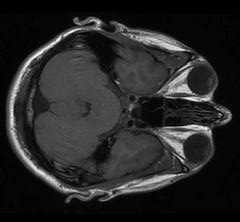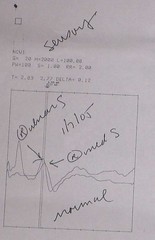The ceftriaxone plan
I went to see the local neurologist yesterday, and the plan we came up with was that once a month I would have three days of injections of Ceftriaxone, also known as Rocephin, at two grams per day.
I would like to thank Scott, with whom I was corresponding about Lyme disease, for being the first to alert me to the beta-Lactam study. Thanks also go to ALife, for providing the Nature article, and to Robert Fenton, for his excellent comments and concerns.
What Robert said was:
#1. The body is remarkably well adapted to down regulating genes that have turned on in excess. I would think that it will be difficult to adjust dosing to activate the promoter just enough to produce a healthy amount of GLT1 without the cell trying to immediately down regulate it. Further, would the patient experience the "law of diminishing returns" such as Parkinson's patients experience.
#2. Ceftriaxone has a very long bio half life. So much so that dosing is almost exclusively q24, and sometimes q12. Would a more stable dosing be required? Further, renal damage would become a concern at some point as well. Not to mention the implications of microbial resistance.....
This is the sort of thing I have read about, and knew about, but which did not occur to me as I was planning to jump with both feet into beta-Lactam antibiotics. Robert administered the smelling salts.
So after I got my parking receipt validated, I sat in the neurologist's waiting room and again read the study. A few things jumped out at me:
-- The mice, rat and human cell cultures responded to the drug within 48 hours, and the effect persisted for at least seven days.
-- The increase in GLT1 expression could be observed in normal rats given the drug, even after three months.
-- In mice engineered to be deficient in SOD1 and thus experience motor neuron loss (a.k.a "ALS mice"), "ceftriaxone treatment significantly delayed loss of muscle strength and body weight," as well as extending life span. This effect was observed within seven days after treatment.
-- (By the way, the study also showed no benefit from minocycline, so I expect the human clinical trial now underway to yield no positive result.)
-- The dosage given to the cell cultures was "comparable to the known central nervous system levels attainable with therapy for meningitis."
You might wonder why the "ALS mice" still died despite their increased expression of GLT1. They only lived about eight percent longer than usual (132 days versus 122). Putting on my rosy glasses, my response is that "ALS mice" are genetically engineered to become messed up. But the human cause is not solely genetic, and so mice and humans may experience different fates under ceftriaxone treatment. I like to think that the mice are doomed to fail, but humans are not.
I took seriously Robert's concern about the body down-regulating the gene expression. However, I was heartened that after three months, the rodents were still expressing at high levels.
The risks are down-regulation, strain on the liver, allergy development, and microbial resistance.
Given that the cell cultures responded within 48 hours and that the effect persisted for seven days, I thought that maybe it would be appropriate to go on ceftriaxone for only three days a month, in order to create a flushing effect, a period in which the motor neurons could clear out excess glutamate. If the effects persisted for seven days, then I would experience the flushing for 10 out of 30 days, or a third of the time. Who knows what benefit might accrue from my motor neurons having normal glutamate transport one third of the time? Maybe complete halt to progression. Hopefully the limited exposure would reduce the chance of Robert's concerns emerging as realities.
I loved making the decision on the fly in the waiting room. I have always trusted my hunches and strategic thinking (yes, especially when my hunch is that I do not have a good idea). I also enjoy debugging complex computer and software problems. And what could be more invigorating than trying to solve a wetware problem where your own life is at stake? So the waiting-room decision was a thrill.
An additional thought I had about the down-regulation threat was whether there might be normal people without ALS who use ceftriaxone on an ongoing basis. It stands to reason that if their bodies down-regulated in the presence of the over-expression, they must at some point experience motor neuron impairment. But we haven't heard of that. Which doesn't mean it doesn't happen.
But first the doc wanted to see if the sleeping hand I have experienced in the right hand each night for a week (except for last night and the night before) was carpal tunnel syndrome. He thought it would be. He has a very simple test using small electrode pads that he says is very reliable. My results were perfectly normal. So I don't have carpal tunnel. I like that result because it means that I can add the limb tingling to the ambiguous Lyme panel results to begin to imply that I have an atypical set of symptoms. I believe that I do have ALS, but I view ALS as a symptom, not a cause. So if my symptom set is atypical, then I hold out hope that my progression will be as well, and that my treatment and cure will be too.
The doc and I talked about my ceftriaxone plan, and he agreed. He looked up the dosage for meningitis and worked from that. By the way, my weight is holding steady at 136.5 pounds in pants and shirt but no shoes, so figure 135 pounds. He decided on two grams of ceftriaxone injected in half-doses twice a day for three days of each month. Originally he was going to do seven days, but I talked him down to three.
Now, the first time the ceftriaxone is injected, there is a chance that I will have an allergic reaction to it. It's potentially fatal. I can say, however, that I've had penicillin and amoxicillin with no allergic reaction, and they're both beta-Lactams like ceftriaxone. Anyway, he wants to inject me with the first dose, and observe me for 20 minutes. They'll have a needle of adrenaline ready and presumably schelp my spastic body across the street to the emergency room if I should have an adverse reaction. I'll be in good hands, or at least among good people.
I said that the conservative thing to do might be to wait until the first human trial is completed. But just between you and me, given the rapid progress that the ALS made in November and December, and still seems to be making (my walking gait and speech are incrementally getting worse), I'm not sure I'll be around in the three years or more it takes to complete a human trail. Or I may have lost a lot of functionality. I feel like the time is right for me to become a guinea pig, be my own human trial, get on the forefront.
The doc affirmed my thinking. You've got the worst disease there is, he said, anything you can do that isn't harmful is a good idea. I don't think it's the worst disease (can anyone say glioma?) but it is pretty bad.
You have to admit that this plan is pretty cool, in terms of the mental movie. He's dying, see, so they come up with an experiment to save him with a drug, but nobody's ever done it before. He could go down in like, the medical textbooks, or he could wind up as, like, a cadaver. Ain't it cool?
In the course of the conversation, the doc, who is a very smart cookie himself, was talking about a friend of his who is very smart. Then the doc made an interstitial remark that he placed this friend in the same "pantheon" as I am in. And he went on. I made a note of that. It's nice to know I'm in the pantheon.
The able office assistance also called me her "favorite patient" in front of the new office assistant and another patient who was, presumably, fighting back tears.
Our objective measure of the efficacy of the ceftriaxone treatment will be the same as that used on the rodents: grip strength. The doc has a thing called a grip dynamometer. I'm going to get one. He had me squeeze it three times, as hard as I could, with each hand. Using the right hand, I got it up to 100. The doc says the best he can do is 94, but he's significantly older than I am. With the left hand the best I could do was 38.
In the rodents, grip strength actually improved. I don't want to practice the test to the extent that I improve my grip through mere muscle exercise. So I think maybe I'll limit myself to testing it once a week.
But wait -- it gets more complicated. When I went to the pharmacy with the prescription, the pharmacist said that my company's drug plan does not cover injectables. The cost to me for one kit would be $520.
However there is the possibility that if the doctor administers the drug, the cost may be covered under the "physician's benefit." That means that they cover what the doctor does to you in the office. So I called the able office assistant and she said that on Monday she will have the new office assistant call my insurer and see if we can get it covered that way.
Those of you in other industrialized countries are no doubt recoiling in horror. Well, this is America. Sick people with no money are thrown overboard.
If it becomes the case that the drug will be covered on the condition that the doctor injects it, I won't mind paying a 10-minute visit to him three days of the month. And he'll be able to test my grip strength.
The Roche Labs manual's section on ceftriaxone ("Rocephin") says that in the case of meningitis, the ceftriaxone can be injected once a day, or in equally-divided doses at twelve hour intervals. In the case that he has to inject me, I will suggest to him that we use one injection a day, instead of two half doses. However, he has said that he is worried that two grams all at once is too much.
Since the antibiotic will tend to kill my internal flora, making, for example, death by diarrhea a possibility, I plan to load up on "probiotics" (oral supplements of the body's natural bacteria), both before and after the injections.
If you read all of this, claim your prize at the door.



<< Home